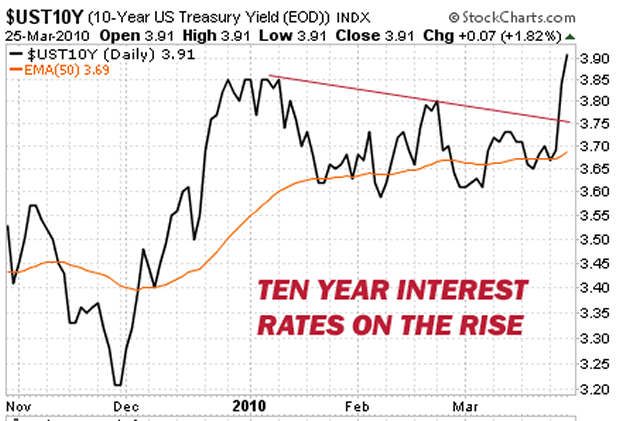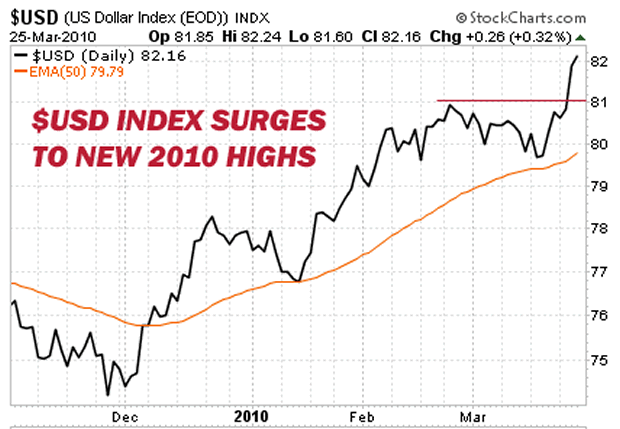Three Breakouts That Could Break the Stock Market Rally
Stock-Markets / Stock Markets 2010 Mar 29, 2010 - 05:24 PM GMTBy: Justice_Litle
 Three “breakouts” of recent days – interest rates, the U.S. dollar and China trade tensions – give ample reason to be cautious.
Three “breakouts” of recent days – interest rates, the U.S. dollar and China trade tensions – give ample reason to be cautious.
Upside breakouts are normally seen as bullish. But in the past few trading days, we’ve seen a few that are anything but.
Breakout #1: Interest Rates
The first breakout of note is in interest rates. After ranging sideways for the first few months of 2010, the 10-year rate is on the rise again – seemingly drawn toward the critical 4% level.

In keeping with the rate breakout, U.S. Treasuries fell hard this week. (For interest rates to rise, bond prices have to fall.) The government routinely raises money by holding “auctions,” in which securities are sold off to the highest bidders through official channels. Fewer buyers than expected showed up for the latest auctions, causing concern.
“De Facto” Default
Higher interest rates make borrowing more expensive. When rates rise, debt service costs go up, for individuals and governments alike. An interest rate spike could thus act like a hammer blow for an economy still in the early stages of recovery.
But the real looming fear is that, at some point, investors – particularly foreign investors – will lose faith in U.S. Treasury bonds.
Because Uncle Sam borrows in his own currency, it is technically impossible for the U.S. government to default. It’s just a matter of printing more scrip.
But if the U.S. government is forced to “monetize” its debt – i.e. pay it off by printing reams of fresh dollars – that could be a de facto default if not a de jure one. (“De facto” is a Latin expression that means “by the fact,” or “in practice.”) When a government monetizes beyond the point of no return, bad debt becomes bad currency. The value of the currency then plummets.
And yet, though bonds took a very hard hit last week, the $USD did not. In fact it is surging.

Breakout #2: The $USD
The $USD breakout offers our second reason for concern.
With apologies to Mark Twain, rumors of the dollar’s death have been greatly exaggerated. For some time now, the dollar’s pending demise has become a note of conventional wisdom.
Here at Taipan Daily, your editor has been a contrarian dollar bull for months now – sometimes to the snorting and scoffing of others – not because he has any great faith in the greenback, but because the euro looked so precarious and the $USD predictions seemed so overwrought.
In the context of a global economic recovery, it is a bad thing for the $USD to be rising. There are a few reasons for this:
• A rising $USD suggests U.S. investors are withdrawing capital from emerging market investments, thus pushing up the dollar as the funds come home.
• A rising dollar threatens the many countries around the world that have smugly issued large amounts of dollar-denominated debt. (Issuing too much dollar debt was the mistake that led to the Asian Currency Crisis of the late ‘90s.)
• A rising dollar hurts U.S. exporters, which further angers American politicians (like Senator Chuck Schumer) and fuels their heated trade-war rhetoric against China.
The dollar’s latest breakout has a lot to do with Europe. As the Greek crisis comes to a head, it has become clear that Germany – the country that wears the pants in the eurozone – does not believe in “ever closer union” when the phrase matters most.
There are open questions as to whether the euro will survive long term, and if so, in what form. Short-term bursts of hope (in respect to Greek resolution) miss the key point: As a reserve currency candidate and a meaningful $USD alternative, the euro can no longer be trusted.
It is simply too plausible, likely even, that when the debt hits the fan for Spain or Italy or Portugal, investors will be put through this same song and dance all over again.
Because currencies trade relative to each other, a euro headed lower means a dollar heading higher. That, in turn, leads to political tension and the escalation of risks as noted above.
Breakout #3: China Trade Tensions
Less than three weeks ago, President Obama unveiled a plan to double U.S. exports over the next five years. "In a time when millions of Americans are out of work, boosting our exports is a short-term imperative," Obama said.
It’s hard to increase exports with a strong and rising currency. When the value of a country’s currency goes up, that makes its goods more expensive for the rest of the world.
This is why China has long held its currency down – to keep exports competitive and sale prices cheap. China’s leaders have long sought to keep the country stable by employing as many people as possible. Exports have been crucial to this goal.
But now the U.S. has an aggressive employment mandate too. Politicians are thus growing increasingly vocal in their criticism of China's currency peg, which they see as unfair competition. Influential columnists, like Nobel laureate Paul Krugman, have argued we should take a “baseball bat” to China in terms of forcing a currency adjustment.
There is no chart for this, but news flow points to a fresh "breakout" in China trade tensions – our third reason for concern. Rhetoric has grown notably heated on both sides.
This is frightening because, among other things, China sits on a massive mountain of dollar-denominated assets. It has been argued, fairly convincingly, that China cannot sell off those assets without doing great harm to its own financial position. But if Beijing’s leadership is forced into a trade war stance, there is no guarantee as to how rational the response will be.
Those who casually argue for punishing tariffs, as Krugman and others do, seem to have forgotten the lessons of the Smoot-Hawley Tariff of 1930, and the dramatic downward spiral in global trade that resulted.
By Justice Litle
http://www.taipanpublishinggroup.com/
Copyright © 2010, Taipan Publishing Group
Justice Litle is editorial director for Taipan Publishing Group. He is also a regular contributor to Taipan Daily, a free investing and trading e-letter, and editor of Taipan's Safe Haven Investor, which helps guide readers to new global investment frontiers and safe harbors.
Justice_Litle Archive |
© 2005-2022 http://www.MarketOracle.co.uk - The Market Oracle is a FREE Daily Financial Markets Analysis & Forecasting online publication.



